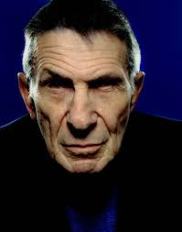Leonard Nimoy died February 27 from chronic obstructive pulmonary disease, a nasty residual, he said, from a lifelong nicotine habit. In memory of the actor-director-author, best known for the pointy-eared, maddeningly logical Mr. Spock from the planet Vulcan in the “Star Trek” TV series and several “Star Trek” movies, here are excerpts from an interview on the set of “Star Trek IV,” shot at San Francisco Studios and Monterey Bay Aquarium.
by Glenn Lovell
Between takes on “Star Trek IV: The Voyage Home,” Nimoy ‒ sans Vulcan ears ‒ talks about the “Star Trek” legacy, his excitement over the latest installment and the long road to acceptance as a bankable filmmaker who also occasionally dabbled in theater (“Six Rms Rv Vu,” “Vincent”) and TV commercials (Hallmark, Western Airlines).
This afternoon on a San Francisco sound stage Nimoy looks more like an Ivy League literature professor, dressed as he is in sleeveless sweater and gray slacks. He refuses to do interviews in character. “He’s very particular about  that,” whispers a member of the crew. “He never does interviews as Spock.”
that,” whispers a member of the crew. “He never does interviews as Spock.”
Unlike others who have been eclipsed by their screen persona (Sean Connery’s James Bond comes to mind), Nimoy has used his popular typecasting as the inscrutable Spock to gain a foothold in other areas of the business. He agreed to “Star Trek II,” only if Paramount granted “other creative opportunities.” The Emmy-nominated role in “A Woman Called Golda” followed. So did the opportunity to direct “Star Trek III: The Search for Spock.”
Some have called this blackmail. Nimoy chooses to look upon it as a shrewd career move. Directing, he says, has always been his first love. Why not trade time in front of the camera for the pleasure of working behind the scenes?
“What people tend to forget is, I’ve been around a long time,” he continues. “I was working on a Hollywood soundstage in 1950. My first movies were ‘Queen for a Day’ and ‘Francis Goes to West Point.’ I even appeared in Republic’s last Saturday-matinee serial, ‘Zombies of the Stratosphere.’
“Directing for me is unfinished business. I started out wanting to direct, as far back as 1960, when I was enrolled in a director’s training program at MGM. But then we did the ‘Star Trek’ TV pilot and the series sold, and my career as a director was sidetracked by my success as an actor.”
Nimoy’s TV credits as director include episodes of “T.J. Hooker,” “The Powers of Matthew Starr” and “Rod Serling’s Night Gallery,” a show on which fellow directors Steven Spielberg and Jeannot Szwarc (“Supergirl”) also apprenticed. “But this picture is my biggest challenge. It’s the most physical ‘Star Trek’ in terms of size and scope. It’s major motion picture time, folks! But there’s almost more texture to this one, a greater range of emotion and humor . . . And we’re dealing with an important, timely issue.”
The environmental/ecology aspects of the new “Star Trek” came to Nimoy as he read a chilling study by Edward O. Wilson called “Biophilia” (Harvard University Press, 1984). It predicts that, if the current rate of pollution continues, the Earth stands to lose 10,000 species a year by 1990. Nimoy sought corroboration from scientists at Harvard, the Massachusetts Institute of Technology and the University of California at Santa Cruz, where he conferred with the school’s dean of natural sciences, Frank Drake.
The research was passed on to Nicholas Meyer and producer Harve Bennett, who will share screenwriter credit with Nimoy. The completed script was hand-delivered to Roddenberry for the final OK. Roddenberry, according to Nimoy, said, “It looks so good it scares me.”
“Gene always meant for ‘Star Trek’ to be more than another science fiction series,” says Nimoy. “He meant for it to be a comment on the human condition ‒ a way of looking at the 20th Century from the perspective of the 23rd. I think the new ‘Voyage Home’ does this better than any of the others.”
Nimoy describes the first “Star Trek” movie, directed by Oscar-winning veteran Robert Wise, as “frustrating ‒ a carefully crafted piece of work that focused on everything but the characters.” The next two movies, in his estimation, “returned the family of characters . . . So we’ve continued to improve with each one.”
But even with the save-the-whales plea, “Voyage Home” is a lot lighter in tone than the others, Nimoy wants it known. “It’s a lot more of a romp, like ‘Raiders of the Lost Ark.’ We zigzag a lot with this one. And Spock is on screen a helluva lot more. He’s alive, but there’s a question of his mental capacity. You’ll see Spock evolve into a three-dimensional character this time.”
Postscript: In all, Nimoy directed six theatrical features, including the hit comedy “3 Men and a Baby.”
Leave a comment